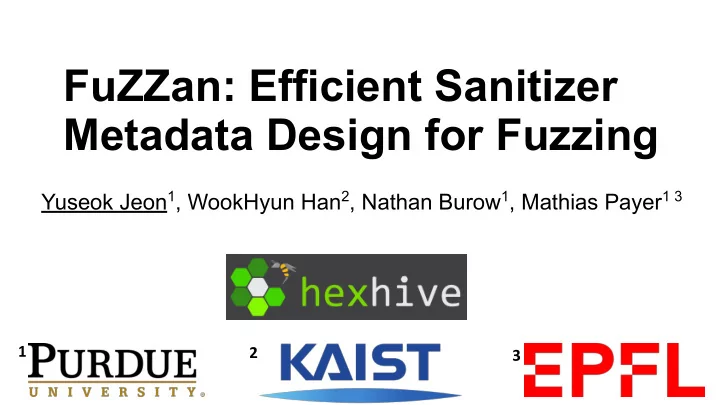

FuZZan: Efficient Sanitizer Metadata Design for Fuzzing Yuseok Jeon 1 , WookHyun Han 2 , Nathan Burow 1 , Mathias Payer 1 3 1 2 3
Sanitizer: Debug Policy Violations ❖ Observe actual execution and flag incorrect behavior ➢ E.g., detect memory corruption or memory leak ❖ Many different sanitizers exist ➢ Address Sanitizer (ASan) ➢ Memory Sanitizer (MSan) ➢ Thread Sanitizer (TSan) ➢ Undefined Behavior Sanitizer (UBSan) 2
Address Sanitizer (ASan) ❖ Address Sanitizer is the most widely used sanitizer Focuses on memory safety violations ➢ Inserts redzone around objects ➢ ➢ Uses shadow memory to record whether each byte is accessible Detected over 10,000 memory safety violations ➢ Shadow memory Process memory Access invalid IsAccessible(p) address “p” inaccessible accessible Bug inaccessible RedZones accessible inaccessible 3
Fuzzing and Context ❖ Fuzzing is an automated software testing technique ❖ To detect triggered bugs, fuzzers leverage sanitizers ❖ Combining a fuzzer with a sanitizer is popular and effective Sanitizers Bug Random inputs Fuzzer Feedback 4
Motivation ❖ Sanitizer is not optimized for fuzzing environment ➢ Highly repetitive and short execution ❖ Adapting ASan increases fuzzing performance overhead ➢ E.g., avg 3.4x (up to 6.59x) Fuzzer + ASan Bug 5
Sanitizers Have High Overhead (1) Memory management ➢ Accessing large virtual memory area incurs overhead ➢ Large memory area causes sparse Page Table Entries (2) ASan initialization (3) ASan logging Page faults Memory management time 1160% overhead 365% overhead [*] Memory manage functions: (i) do_wp_page, (ii) sys_mmap, (iii) unmap_vmas, and (iv) free_pgtable 6
FuZZan ❖ Introduce alternate light-weight metadata structures ➢ Avoid sparse Page Table Entries ➢ Minimize memory management overhead ❖ Runtime profiling to select optimal metadata structure ❖ Remove ASan logging overhead ❖ Remove ASan initialization overhead 7
FuZZan Design Fuzzer Target Target Dynamic feedback Fuzzing FuZZan sampling Measure target program behavior 1 module ASan 2 Switch shadow memory Calculate the optimal metadata structure FuZZan Metadata RB-tree structure 3 Switch to selected FuZZan Min- selector optimal metadata shadow memory structure 8
New Metadata Structures ❖ Propose two different light-weight metadata structures Memory Metadata Metadata Target Management Structures Access Cost Cost Low Address Sanitizer High O(1) High Few metadata RB-tree Low access O(log n) FuZZan Low Frequent Min-shadow Medium O(1) metadata access 9
ASan Memory Mapping Stack Stack 20TB Heap (4TB) Heap (4TB) (Shadow memory Shadow Shadow + Heap) 16TB Bad Bad (Shadow memory) Shadow Shadow BSS & Data BSS & Data & Text & Text 10
Min-shadow Memory Mapping Bad Bad 512MB Shadow Shadow (Shadow memory) 1.5GB Stack (1GB) Stack (1GB) (Shadow memory Heap (1GB) Heap (1GB) + heap) 4GB BSS & Data BSS & Data & Text & Text 20TB -> 1.5GB 11
Other Min-shadow Memory Modes ❖ Create additional min-shadow memory modes ➢ To accommodate large heap size ➢ 1GB, 4GB, 8GB, and 16GB Shadow Memory Shadow Memory Shadow Memory Shadow Memory 512MB 896MB 1.4G 2.4G Bad Bad Bad Bad Shadow Shadow Shadow Shadow Stack (1GB) Stack (1GB) Stack (1GB) Stack (1GB) Heap (1GB) Heap (4GB) Heap (8GB) BSS & Data Heap (16GB) BSS & Data & text (2GB) BSS & Data & text (2GB) & text (2GB) BSS & Data & text (2GB) 12
Dynamic Switching Mode ❖ Switch to selected metadata structure during fuzzing (1) Avoid user’s manual extra effort to select optimal metadata structure ➢ No single metadata structure is optimal across all applications ➢ E.g., RB tree for allocating few objects (2) Change metadata structure according to the target’s behavior ➢ Profile at runtime and switch to selected metadata structure ➢ E.g., find new path (3) Increase heap size when target exceeds limitation 13
Sampling Mode ❖ Periodically measure the target program’s behavior ➢ Metadata access count (stack, heap, and global) ➢ Heap object allocation size ❖ Maintain ASan’s error detection capabilities 14
Initialization/Logging Overhead ❖ Use fork server to avoid unnecessary re-initialization ➢ E.g., poisoning of global variable ➢ Move ASan’s initialization point before fork server’s entry point ❖ Modify ASan to disable the logging functionality ➢ Complete logging can be recovered with full ASan 15
Detection Capability ❖ Juliet Test Suite ➢ NIST provides a test suite of all CWEs called Juliet ➢ Test using memory corruption CWEs ➢ Verified pass or fail all test cases as ASan ❖ Address Sanitizer provided unit test ➢ Verified pass all possible test cases ❖ Fuzzing test using Google Fuzzer Test Suite ➢ Fuzzing using 26 applications in test suite ➢ Verified same detection capability during fuzzing CWE: Common Weakness Enumeration 16
Metadata Structure Performance 199% 43% 40% 38% 36% 17
Performance Optimizations Compared to Asan 19% 11% 25% Compared to Asan Compared to Asan 43% 48% 48% FuZZan-Logging-Opt: optimization for logging overhead FuZZan-Init-Opt: optimization for Initialization overhead FuZZan-Min-1G-Opt: min-shadow memory (1G) mode with logging and initialization overhead 18
Dynamic Switching Performance [*] The number on each bar indicates the total metadata switches 19
Performance Overhead Analysis Memory management time Page faults 38% 62% 16% Fuzzer + ASan Fuzzer + FuZZan Bug 20
Bug Finding Speed Testing 46% 61% 43% 24% 43% 21
Real-world Fuzz Testing Total execution number Unique discovered path 61% improved 13% improved * the (M) denotes 1,000,000 (one million) 22
Conclusion ❖ Combining a fuzzer with sanitizer hurts performance FuZZan massively reduces performance overhead ❖ Novel metadata structures to condense memory space ➢ ➢ Dynamic switching between metadata structures Removing unnecessary operations ➢ FuZZan improves fuzzing throughput over ASan ❖ ➢ Improves fuzzing throughput by 48% starting with provided seeds ■ 52% starting with empty seeds Discovers 13% more unique paths given the same 24 hours ➢ Provides flexibility to other sanitizers and AFL-based fuzzers ➢ https://github.com/HexHive/FuZZan 23
Recommend
More recommend